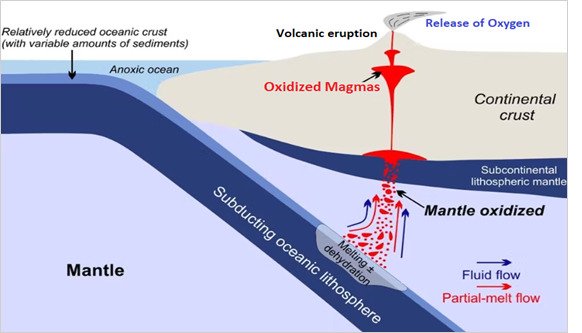Skip to the content
- A study published in Nature Geoscience contends that at least some of the Earth’s early oxygen came from a tectonic source through the movement and destruction of the Earth’s crust.
- Subduction is a phenomena in which an oceanic plate slides beneath a continental plate.
Subduction
- Plate tectonics refers to the tectonic activity that currently dominates the Earth. The oceanic crust, the topmost layer of the Earth underneath the oceans, subducts, or sinks, into the Earth’s mantle.
- A continental plate collides with an oceanic plate and descends beneath it. The space between Earth’s crust and core is known as the mantle.
- At regions of convergence known as subduction zones, the oceanic crust dips into the Earth’s mantle. According to the report, there is substantial disagreement on whether plate tectonics existed throughout the Archean epoch, which accounts for one-third of Earth’s history.
The Archean Earth
- The Archean eon, which spans 2.5 billion to 4 billion years ago, accounts for one-third of the history of our world.
Features
- This alien Earth was a water world, with green oceans covering everything (Green Rust-an Iron Mineral)
Earth’s Iron ore deposits
- “Green rust” that formed in seawater and sank to the ocean floor millions of years ago is the origin of banded iron formations.
- The minerals we can currently see in the geologic record were created from the iron in the green rust.
- Its atmosphere was obscured by a methane haze, and there was no oxygen in the air. It may have indirectly contributed to the Great Oxidation Event, when oxygen began to build up in the atmosphere.
- There was no multicellular life at all.
- Prokaryotes, or simple single-celled organisms without nuclei, were the only living things.
- The nature of this world’s tectonic activity was another strange feature.
Creating oxygen from water
- According to the experiment, the magma’s sulphur level rose from 0 to 2000 parts per million over the course of 2705 million years.
- This suggested that the sulphur content of the magma had increased.
- Additionally, it was confirmed that the sulphur originated from an oxidised source that matched the information from the host zircon crystals.
- It suggests that oxidised magmas did originate 7 billion years ago, during the Neoarchean period.
New findings indicate
- The oxygen in these magmas must have come from another source and was ultimately released into the atmosphere during volcanic eruptions, as the development of sulfur-rich, oxidised magmas in the subduction zones was not prevented by the absence of dissolved oxygen in the Archean Ocean reservoirs.
Importance
- The study extends beyond the understanding of early Earth geodynamics, and it suggests that oxygenation of the Earth may have been greatly aided by archean subduction.
- Future research on life on other rocky planets and the lack of oxygen may be partially explained by the findings of this study.
@the-end
- The presence of magmas shows that subduction, which forces ocean water to travel hundreds of kilometres inside Earth, produces free oxygen, according to the paper. The result is oxidation of the mantle above.
- The study came to the conclusion that an unanticipated factor in the oxygenation of Earth may have been Archean subduction. The only planet where life could exist is Earth, which may be the only spot in the solar system with plate tectonics and active subduction.

